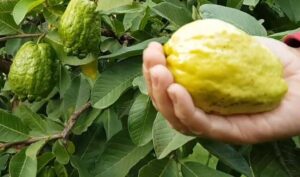In this guide, you are going to learn how to protect your guava trees from insects.
Short answer: to protect your guava trees from insects, prune guava tree branches that are touching walls, buildings, and ground timely. This can help prevent aphids, ants, and other insects pests from touching or getting access to your guava. If that doesn’t work, use pesticides.
Read on for a detailed information about protecting guava from insects pests.
Overview
The guava tree is one of the many trees with hardwood which may be hard for insects to damage. However, despite the guava plant possessed hardwood stems, trunks, and branches, the plant has its own share of pests.
The common pests of guava include:
- Nematodes
- Stem borer of guava
- Eating caterpillars
- Mealybugs
- Thrips
- Weevils
- Green shield scale
- Guava whiteflies and others
You can find out more information about guava pests and their management from here and here.
How to Protect Guava Tree from Insects

There are several ways in which you can deter or prevent your guava plants from damage by insects.
And they include:
- Use of biological control agents
- Chemical control method
- Planting of resistant varieties
- Use of agricultural practices
Use of Biological Control Agents
Insect pests like stem borer of guava can be controlled biologically by introducing their natural enemies such as green meadow grasshopper and spiders.
These insects can help protect your guava from attack by their prey by reducing the population of guava stem borer.
Chemical Control Method
This method of protecting guava from insects involves the use of chemicals to destroy or reduce the population of insect pests.
To protect your guava from insects using the chemical control method, spray a pesticide containing an active ingredient Fenthionin to the infested guava trees.
You can alternatively apply a pesticide, which contains the active ingredient Dimethoate. To prepare the insecticides, follow the instructions given on the product to spray your guava with the pesticide.
Prepare 5-10 liters of the pesticide when applying the pesticide on guava fruits and leaves.
Spray your guava plantation weekly and stop when you see that the pests are under control.
Planting of Resistant Guava Varieties
When planting your guava, always buy and plant guava varieties that are resistant to diseases and pests. This way, your guava can be resistant to attack by pathogens and insect pests.
Learn more about the different guava varieties
Implementing Good Agricultural Practices
Another easy and effective way to deter insects and keep their population under control is the use of good agricultural practices.
Make sure you timely prune your guava trees to reduce dense canopy. This can help allow good passage of air in and out of your guava plantation.
Weeding guava plantation can also help keep the population of insects under management.
Irrigate and fertilize your guava to restore the plant vigor. This can help your guava withstand the effects of pests even when the guava is infested by pests. You can use nitrogen-based fertilizer to feed your guava.
Practice Crop Rotation. Plant other host plants around the area of guava trees plantation. This can help reduce the population of insects on your guava trees to the other host plants.
Other Management Practices and Takeaway
- Always allow wider space between two guava plants when you are planting guava
- Collect and burn infested stems, fruits, and leaves
- Cut guava branches that rest on or touching the wall, this will help remove the bridge that other insects such as ants will use and damage your guava
References
Sathe, Tukaram. (2015). STORAGE INSECT PESTS OF GUAVA PSIDIUM GUAJAVA LINN. International Journal of Current Research. 7. 21015-21018
Sarwar, Muhammad. (2006). Occurrence of Insect Pests on Guava (Psidium guajava) Tree. 38.





Comments
I do believe all of the ideas you have introduced on your post. Angy Dudley Kiehl
Author
You are welcome
Useful information. Can you tell me what causes dry brown areas on the surface of the fruits. They are good inside but lack commercial value due to the bad appearance
Author
This can be caused by both insect pests and diseased pathogens. You learn more her:
1. https://www.guavafacts.com/diseases-of-guava/
2. https://www.guavafacts.com/pests-of-guava-control/
Major thankies for the article post. Much thanks again. Really Cool.
Author
You are welcome